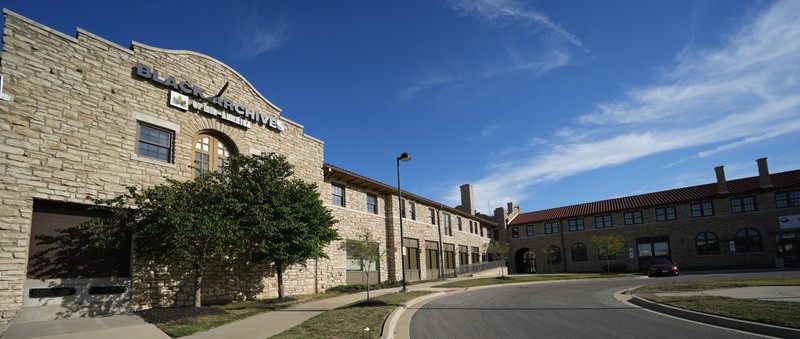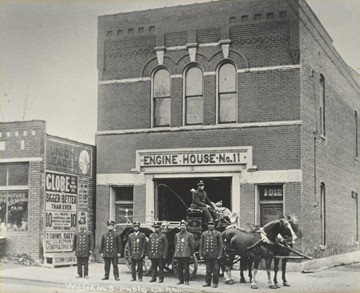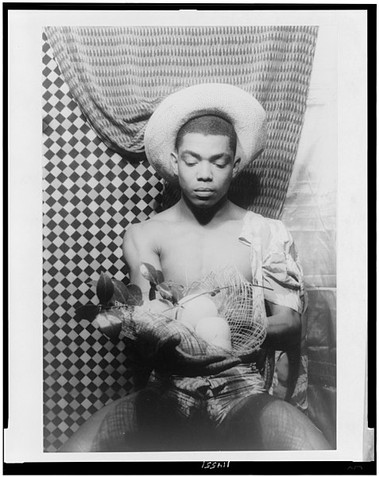Black Archives of Mid-America
Introduction
Author-Uploaded Audio
Introduction by Michael Patton; recording created by Black Archives of Mid-America
Text-to-speech Audio
Established as a community museum and archive in 1974 under the leadership of Horace Peterson III, the Black Archives of Mid-America in Kansas City offers a host of programs throughout the year in addition to several galleries and event spaces. The archives closed temporarily in 2006 due to financial problems, but a community fundraising drive and support from the Kaufmann foundation allowed it to not only re-open, but also expand into its present location in the old Parade Park Maintenance Building. The Archive's permanent exhibit on the first floor, "With My Eyes No Longer Blind" is named in honor of a Langston Hughes poem, "I Look at the World." This exhibit traces the story of African Americans in Kansas City and the surrounding region. The organization also offers a research facility for historians and genealogists and a recording studio for oral histories, educational videos, and other media.
Images
The Black Archives of Mid-America reopened in 2012 in the restored Parade Park Maintenance Building.

BAMA was located in this historic firehouse from 1976 to 2006. The firehouse, built in 1931 by the Works Progress Administration, housed the first Black fire company in Kansas City.

The famous choreographer Alvin Ailey left his papers to the archive after his death in 1989.

Backstory and Context
Text-to-speech Audio
Horace Peterson III established the Black Archives of Mid-America in 1974 to preserve papers and artifacts pertaining to African American history and culture in Kansas City. Many of the organization's original materials were gathered by Peterson and other members of the community. Peterson opened the archives in the old YMCA building on Paseo (the street was later renamed Dr. Martin Luther King Jr. Boulevard, though in 2019, some city residents launched a campaign to reverse the renaming). The next year, he began the first of the archives' research projects: a collection of oral histories with African American individuals, including civil rights activist Mamie Hughes and Representative James McKinley Neal.
Two years after the organization's founding in 1976, the archives moved into the old firehouse building at 2033 Vine, a building that had previously served as the home of the first Black fire company in Kansas City. Peterson's death in 1992 left the organization without its founder and champion, and despite multiple challenges, the former firehouse remained open as the archives' home until 2006 when the organization temporarily closed. At one point, the power was shut off and Jackson County even sued the archives for failure to pay taxes. This period left researchers without access to important records and the collections housed in the building, including documents about the all-Black army regiments known as the "Buffalo Soldiers," a slave cabin brought from Trenton, Missouri, and an original document freeing Missouri's slaves, were at risk.
In 2006, Black Archives of Mid-America lost its status as a non-profit, as well as the annual subsidy provided to it by the city. It took more than half a decade of hard work from a new board, chaired by Barbara Peterson (Horace Peterson's widow), as well as significant philanthropic gifts, to move the archives to their current location in the historic Parade Park Maintenance Building. In 2012, the archives opened in the new space, showcasing the permanent exhibit "With My Eyes No Longer Blind," so titled after a line from the Langston Hughes poem "I Look at the World."
The archive continues efforts to secure financial support even as historians uncover powerful stories in their collections. In the Alvin Ailey papers, for instance, scholars recently discovered compelling evidence of the influence of Brazilian musical and dance traditions on the choreographer and his "search for collective identity through and in dance." The collections' strength lies in their ability to trace such connections between far-flung places and rich local history, which has made them foundational sources for digital scholarship projects like The Pendergast Years.
The Archives also share the history of communities such as the 18th and Vine neighborhood. The gradual end of formal segregation allowed Black city-dwellers to more freely access businesses beyond segregated neighborhoods, but this also brought challenges to the existing business in the 18th & Vine area and other Black neighborhoods. Businesses and venues associated with the pre-war jazz age shuttered. Redevelopment projects razed many historic buildings to clear space for industry and parking lots. It wasn't until the 1990s that there was a concerted push in the other direction, toward the preservation and restoration of the landscape associated with the first half of the twentieth century and the remarkable artistic and cultural legacies it left. The result of these efforts can be seen throughout the 18th & Vine neighborhood which is home to the Negro Leagues Baseball Museum, the American Jazz Museum, Black Archives of Mid-America at Kansas City, and venues such as the Gem Theatre and Blue Room.
Sources
- McClain, Cara. “Timeline: A Look Back at 40 Years of Kansas City’s Black Archive.” Accessed February 13, 2020. http://kcur.org/post/timeline-look-back-40-years-kansas-citys-Black-archives#stream/0.
- "History and Founder of the Black Archives," Black Archives of America. Accessed February 13, 2020. http://Blackarchives.org/about/history.
- Smith, Deann. "Striving to save pieces of past - More than 150 people gather in KC in a bid to get the troubled Black Archives back on track." Kansas City Star (Kansas City, MO) August 18th 2006.
- McClain, Cara. “Timeline: A Look Back at 40 Years of Kansas City’s Black Archive.” Accessed February 13, 2020. http://kcur.org/post/timeline-look-back-40-years-kansas-citys-Black-archives#stream/0.
- Ananya Jahanara Kabir and Francesca Negro, "Solano Trinidade's Gift to Alvin Ailey: New Evidence from the Black Archives of Mid-America," Journal of Black Studies and Research 49, no. 3: 6.
.
Photo by David Trowbridge
Black Archives of Mid-America
Photograph by Carl Van Vechten. Wikimedia Commons/Library of Congress.
